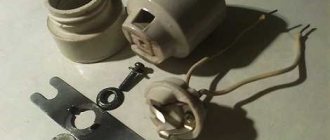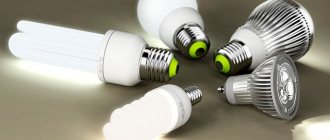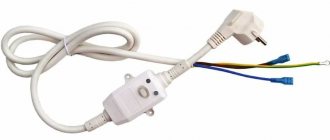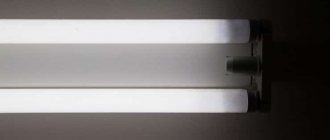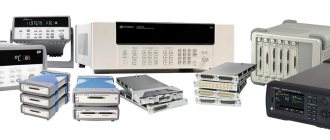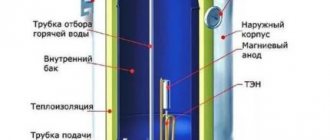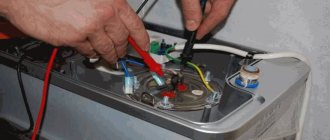Normal distribution of potentials in sockets
Two phases in a socket
Before you figure out why there are two phases in sockets at once, you should know that a pair of supply wires are supplied to the apartment along the electrical wiring line, one of which is called phase, and the second is called zero. The potential of 220 Volts operates only on one of the socket terminals, and on the second it is zero. You can verify this by using a regular indicator screwdriver.
The presence of two potentials (phase and zero) is a prerequisite for the operation of any power supply system.
If the socket does not have one phase or for some reason the zero is missing, it will not be possible to obtain the difference between their values (220-0 = 220 Volts), called voltage. Therefore, if the zero in the sockets is missing, and you don’t know how to find it, before starting the search you should familiarize yourself with the principle of potential formation. The situation is much more complicated when, instead of zero, another phase appears on the second terminal. To eliminate this problem, you will need to understand the reasons for its occurrence.
What happens if you connect two phases?
If you close the same phase with each other, no voltage will appear, but the protection should work. If you do not short-circuit the conductors, there will be 380 V between them. In the event that the phases are different, a short circuit will occur when 2 different phases come into contact. As a result, in the best case, the fuse will burn out, and in the worst case, the substation or house will burn out.
transformer Source regpovestka.ru
Reasons for the appearance of two phases
The appearance of a phase on two wires at once can be explained by the following combination of circumstances:
- A break in the neutral wire in the input panel of a house or apartment.
- It is damaged at the input or inside the junction box.
- Contact failure in the “zero” connection in only one socket.
- Short circuit of the phase wire to the neutral conductor due to insulation damage.
To understand why the indicator shows the phase on both wires at once, the reason that caused each of these phenomena will need to be considered separately.
If there is no zero in the socket, first of all you should find the place where it disappears (break). A possible option is damage to the cable at the entrance to the house or apartment, as a result of which the “zero” will disappear in all sockets installed inside the building and in individual rooms. In addition, the contact can be broken anywhere in the electrical circuit, including at the input or inside the distribution box, which will lead to the malfunction of only a few sockets.
The second case concerns those of them that are connected within the room to this particular distribution node (that is, approximately half), and in all other installation products the normally working “zero” will remain.
If there is a fault only at the input to a specific socket, the disappearance of zero and the appearance of the second phase will be observed only in it. In order for the situation under consideration to form completely - voltage reaches the broken neutral contact - it will be necessary for the exposed phase wire to accidentally short-circuit to it.
A variation of the latter case is when the neutral wire is not broken, but the phase wire with damaged insulation is shorted to the ground contact. This will also lead to the appearance of two high potentials in this outlet at once.
How to look for a zero break in an apartment: 2 methods
Troubleshooting can be done:
- safe by continuity - on completely de-energized electrical wiring;
- under voltage, which requires the skills of an electrician of at least the third safety group.
How to call an electrical wiring diagram quickly and safely in 3 steps
Stage No. 1. Disconnect the input switching devices and check the absence of voltage
If there are usually no problems with removing power from a circuit breaker or fuses, then many electricians do not pay attention to checking for the absence of voltage, but in vain.
One second is enough to poke the indicator at the control point. This will prevent you from getting under voltage due to:
- switch contact sticking;
- turning off the wrong section of the circuit;
- the presence of “clamps” in the circuit;
- other errors.
Stage No. 2. Overall chain continuity
The digital multimeter is switched to continuity mode or ohmmeter mode to measure ohmic resistance. We take any long insulated wire. One end of it is connected to the disconnected zero bus. The second one sits on the terminal of the device.
The second ohmmeter probe is passed through all sockets. An electrical circuit should be created on one of them when the device shows a small wire resistance (the normal state of the zero circuit), and on the second there will be a large one - ∞ (no electrical contact of the phase with the potential of the zero bus). This is fine.
When the multimeter readings are different, you need to look for the fault further. The multimeter will show a broken zero circuit with high resistance in both sockets.
The correct connection of the zero bus must be checked by two sequential actions after turning it on: Measuring the voltage between its potential and the ground, taken on the ground loop or, in extreme cases, on the water supply, heating battery (let's say a difference of several volts due to poor contacts of non-standard ground electrodes). Subsequently check with an ohmmeter, which should show a short circuit.
Stage No. 3. Troubleshooting the outlet block and junction box
When the ohmmeter shows an open circuit between the socket contact and the zero busbar, then this entire section must be divided into segments, and then each one must be called out step by step.
To begin with, it is more convenient to remove the housing from the socket, inspect and check the condition of the contact on a suitable wire. Then the junction box is looked for, opened, the zero assembly assembly is determined (usually the thickest) and the insulation is removed from it.
From this place the circuit is connected in two directions: to the socket and to the zero bus. There will be a cliff in one direction. It should be further examined. If a wire core is broken, it must be replaced if there is a reserve.
However, the detected wire damage may appear again. Therefore, it is better to replace the entire cable section in this section. It is simply attached to one end of the old one and, while pulling out the damaged piece, at the same time tightening the new one.
Finding a voltage zero break: detailed instructions
Checking the presence of voltage with a capacitive indicator shows only the presence of a phase. It does not determine the magnitude of the potential difference, that is, voltage. This is the main mistake.
The fault finding technology should be expanded and work with a voltmeter. Now this function is available in all modern digital multimeters and old pointer testers.
Working with a voltmeter is dangerous. It requires compliance with security measures. You can get stressed.
In principle, this work has already been partially done. All that remains is to completely turn off all consumers, freeing the sockets from the inserted plugs. At the same time, turn all light switches to the “Off” position. This will facilitate troubleshooting and simplify analysis.
Then, using a capacitive voltage indicator, we carefully check all the sockets and write down those that raise doubts.
We take a voltmeter, measure the voltage in all sockets, and compare the readings.
On serviceable sockets the result of the current voltage of the household network (about 220 volts) will be shown, and on damaged ones - zero. We will have to deal with them further.
You can, of course, disassemble sections of the circuit into segments and measure places where the voltage does not reach. But, I recommend that the home master not go this route, but simply turn off the input machine and call up the circuit using the above technology. It's much safer.
After troubleshooting, inexperienced electricians in a hurry can create a short circuit by applying voltage to the repaired area with shorts or jumpers left in place. Before turning on the machine, check that there is no short circuit in the continuity circuit.
Possible consequences and danger of the appearance of two phases
When there are 2 phases in a particular outlet, you must first of all worry about what this threatens for the people using it. This situation is unacceptable for the following reasons:
- The potential difference between the socket terminals will be 220-220=0 Volts.
- The voltage will be lost and connected household appliances will not work.
- A danger arises due to the loss of the protective grounding circuit, which in old houses operates through an earthen conductor (due to the lack of a local circuit).
In this case, there is no need to talk about any protection at all; the consequences may be unacceptable to people. An ignorant electrician, believing that he touches the neutral wire (in blue insulation), may find himself under high voltage. Therefore, the regulatory documentation requires that when disassembling installation products, it is imperative to check the absence of a phase on both terminals using an indicator.
In this situation, all or only the light switches connected to this junction box will also stop working. This is explained by the fact that a phase potential will appear on the neutral wire supplied to the chandelier, connected to the corresponding contact of the socket, and the voltage difference will become zero.
A brief excursion into theory
Today we will not delve too deeply into the theoretical foundations of electrical engineering, but will try to briefly explain the essence of the problem. For those who wish to become more familiar with this issue, we recommend reading a series of articles on the physics of alternating electric current on our website.
Standard switch installation.
Let us take as an example a fragment of a household electrical network, where the connection of an electric lamp and a plug connector (socket) is organized.
Fragment of a household network with connection of a lamp and socket
Designations:
- L – phase.
- N – zero.
- Ps – socket.
- Sw – light switch.
- Lm – lamp.
As is known, in single-phase circuits the electric current (Ì) flows from phase to zero. In the above figure, the switch SW is in the open position, therefore the lamp will be de-energized, which can be verified by measuring the voltage U2. In this case, the operating potential U1 corresponding to the phase voltage will remain on the plug connector and the part of the network up to the switch (marked in red). This is the normal operating mode for this circuit, where the switch opens the phase wire.
Please note that if you take measurements with a voltage indicator, it will show the presence of a phase on one of the contacts of the plug connector and its absence on both contacts of the lamp socket.
Setting the switch to zero
Now let's see what happens if you swap the phase and zero, or, what is more common in practice, set the switch to zero, and not the phase wire.
Switch installed incorrectly
Outwardly, such a change will not manifest itself in any way. The lamp will turn on and off in the same way as in the previous example, and a potential difference will be present at the contacts of the socket. But, certain nuances arise, which manifest themselves in the presence of voltage at the contacts of the socket and part of the zero line between the lamp and the switch. This is easy to verify using an electrical probe.
This connection option carries a potential risk of electric shock when attempting to replace or repair the lamp.
It is typical that measuring the presence of voltage between the contacts of a lighting fixture socket with a voltmeter will not bring results. The device will show “0”, since the contacts will have the same phase potential level.
Summarizing the results of the chapter, we can state that incorrect connection of switch contacts in the distribution box does not have a significant effect on the operation of electrical appliances connected to the outlet. In addition, we found out about the need for the combined use of measuring instruments (voltmeter and probe).
Recommendations for troubleshooting
If there are two high potentials at the terminals of old-style sockets (2 phases and grounded zero - for new installation products with three contacts) - this situation requires urgent intervention. Since it is associated with a break in the neutral core, you first need to find the exact location of the damage using visual inspection methods plus the necessary tools. To do this, you will need to take actions depending on the nature of the damage.
When the problem affects all sockets in the residential premises of an entrance hall or a specific apartment, you should call an electrician who has access to the distribution cabinet and the input circuit breaker. If the malfunction is observed only in the apartment (on one/several distribution boxes or in a separate outlet), it is possible to fix it yourself. To do this you will need to perform the following operations:
- Turn off the input circuit breaker, located in the common corridor and supplying voltage to the entire apartment.
- Inspect the junction box, at the input of which or inside there is supposedly a fault hidden.
- If an obvious break (poor contact) is detected in the wire entering or leaving the box, it is necessary to restore the broken circuit using a simple tool - a soldering iron or a screwdriver.
- If the fault appears only on one of the sockets, you should remove its cover and carefully examine all contacts.
- If you find a loose fastening on the zero terminal, you must tighten it using a screwdriver.
In order for the second phase to disappear from the sockets and the chandelier to start burning again, you will also need to isolate the damaged phase core from the already restored “zero”.
Only if you follow the appropriate instructions can you eliminate the detected fault observed in all, half or only one socket. The appearance of two phases, regardless of the total number of sockets involved, most often occurs when the rules for using household electrical products are violated.
What happens if you connect phase and zero?
When a phase and zero are connected, a short circuit occurs. Zero is the neutral of the transformer. This is the central point to which the beginnings of its 3 windings are connected at the transformer substation. The end of any of these 3 coils is a phase, between it and zero a potential difference of 220 V is formed, since the transformer is connected as a star. When a phase is connected to zero, the resistance becomes zero. The current tends to reach the maximum value that the transformer is capable of. Therefore, a short circuit occurs.
general information
The appearance of two phases is determined using special devices - voltage indicators and voltmeters.
In most apartments/houses the wiring is hidden. As practice has shown, it is more vulnerable than those installed openly. The latter will not be pierced by accident if it is necessary to hang a picture or a carpet. With hidden wiring it is more difficult. It is difficult to determine its location, because builders usually do not leave diagrams, and the equipment for such work is expensive.
Damage varies. Often an apartment/house or some separate room is left without electricity. In cases where circuit breakers are installed that quickly eliminate short circuits, this is not noticeable. If they are absent, the malfunction will be manifested by the appearance of sparks and smoke.
While such damage can be prevented, there is no protection against damage to the junction box. There are several reasons for their appearance:
- The work on connecting the wires was done poorly.
- The junction has oxidized and collapsed.
- A connection has been made between the aluminum and copper wires. When exposed to moisture, the wires oxidize, resulting in breakage.
Such faults are easily detected by the smell of burnt insulation.
Break of neutral conductor
If there is a zero break, electrical appliances connected to the outlet will not work. Perhaps the voltage will disappear in other sockets.
If the breakdown occurred for this reason, then the solution is quite simple. It is enough to turn off the equipment from the network. What to do next:
- Identify outlets without voltage. At this stage, a voltmeter, test load or indicator screwdriver will be useful. You should not use a single-pole indicator - it is useless. It is prohibited to use an incandescent lamp as an indicator. If exposed to 380V voltage, it may explode and cause injury.
- Next you need to find the damaged part of the wiring.
If you cannot do the work yourself, you should contact an electrician.
Break of neutral conductor with short circuit to phase
If the neutral wire breaks with a short to phase, it is not enough to just turn off the electrical appliances. This will not eliminate the appearance of two phases.
Broken phase conductor
If the indicator in the socket does not show anything, there has been a break in the so-called phase. Its location is easy to determine. It is necessary to check the presence of phase in the junction boxes located between the electrical panel and the damaged socket.
Protection devices
Despite the presence of protective elements (RCDs, circuit breakers), many houses have fuses. If the fuse at “zero” fails, the second phase will go to the sockets.
It is easy to correct the situation if you find the short circuit. It is necessary to turn off the lights, unplug appliances and install a new fuse. If it breaks, the breakdown concerns the wiring. Otherwise, when the fuse is OK, the fault should be sought in the equipment.
Mains faults
Another reason for the appearance of two phases in an outlet is a network failure. More often this is a break in the neutral wire. It can break anywhere, from a substation to a panel in a multi-story building. At the same time, electricity will not be lost in the apartments. In particularly difficult cases, the voltage will rise to 380 V, which will damage household appliances.
Two phases in an outlet also occur due to a phase/neutral short circuit on the power line.
This is a dangerous malfunction, because even RCDs do not always have time to respond. As a result, a fire occurs.
Only electricians should search for and repair power supply faults.
Overvoltage has occurred
Two phases also appear due to voltage surges (increase or decrease) in the network. This manifests itself in the blinking of light, too bright or, conversely, dim light bulbs. An increase is especially dangerous, because the equipment cannot work fully or burns out.
How to proceed:
- Turn off the power supply to the apartment/house.
- Turn off the equipment.
- Turn off the lights (set the switches to the “off” position).
- Call electricians.
Why can't you act on your own? Firstly, the slightest inaccuracy in work can lead to tragic consequences. Secondly, electricity is connected only after a fault report has been drawn up.
Damp walls
Often two phases are a consequence of excess moisture. Damp walls can cause a short circuit. The neutral wire will either fall off or stick to the phase.
To eliminate the breakdown, you need to find the location of the short circuit. Then you will have to change the wires from the socket to the distribution panel
It is also important to get rid of dampness and prevent its further occurrence.
How to determine using an indicator
You can detect the presence of voltage in the outlet using a special indicator screwdriver. After the lights in the room are turned off, you need to check any socket using an indicator. Bright blinking of the screwdriver in two sockets indicates the appearance of the second phase.
Next, you need to determine where the breakdown occurred: inside the apartment or on the external panel. To do this, you need to take any household device and connect it to the outlet closest to the panel. The device must be turned on. This is necessary so that the voltage flows through the device to the neutral conductor. All other equipment must be turned off!
Consequences
For an electric motor, operating in two phases out of three is emergency and extremely undesirable. Also, in three-phase networks, due to the loss of one of the phases, the uniformity of the load of the transformers and the network as a whole is disrupted. For a three-phase electric stove, this mode of operation is not so dangerous - some burners simply will not work. All this leads to increased current in the neutral wire, its possible burnout and further development of emergency situations.
In conclusion, I would like to note that the solution to the problem of lack of voltage in an apartment or on a specific line essentially lies in checking all connections and switching equipment of this line. There are only two reasons for it - either phase imbalance, or burnout of the conductor due to poor contact or increased load. We strongly recommend: when working in electrical wiring, turn off the power and, if possible, work with approved dielectric gloves. Do not interfere with access switchboards and electrical networks - it is better to have this done by electricians from the organization on whose balance sheet this network lies.
Now you know the reasons why a situation arises when there is no phase on the light switch, socket or on the chandelier itself. We hope the tips we provided helped solve your problem!
Checking the correct connection of the switch
The most important part of the article, which says how to determine the connection diagram of the switch (check whether it breaks - phase or zero), and its serviceability.
What is the sign that the switch is opening - phase or zero? Using an indicator screwdriver, this is easy to determine.
In both cases, when the switch is open, there should be a phase on one of its contacts, and zero on the other
This is provided that the lamp (no matter incandescent or fluorescent) is screwed in and in good working order
Checking the phase on the switch
But when closing the switch contacts, two options are possible.
- Zero at both ends. This indicates that the switch breaks the zero circuit, and when the switch is open, there is a phase on both terminals of the light bulb.
- There is a phase at both ends. This means that it was done according to the rules, the switch interrupts the phase, when it opens, there is only zero on the light bulb. And, which is logical and fundamental, when a light bulb is shorted on one terminal, it is zero, and on the other, phase.
Let's consider the options for connecting the switch and the presence of a phase on it.
Correct connection, phase on the switch:
Option 1. A phase breaks on the switch. Where and in what cases is there a phase or not.
Let’s look at the points of the diagram, and I’ll give my opinion on each one. We go from phase to zero, clockwise.
- There is always a phase, this is the electrical panel.
- There is always a phase. There may be no phase if there is a break in box 1.
- There is a phase when the switch is closed and the circuit is assembled to zero (there is a light bulb and all connections are in order). When the switch is open and the circuit is complete, there should be a zero. If the zero is interrupted somewhere (for example, there is no light bulb), then an undefined voltage may be present, and the indicator screwdriver will glow dimly.
- This should be the center contact of the lamp socket. Same as point 3. If different from point 3, then there is no contact in box 2.
- Must always be zero. If a phase is present, it means there is a break in box 3.
Now let's consider the “wrong” option, when the switch breaks zero. We go from phase to zero, counterclockwise.
Option 2. The switch breaks zero. Where and in what cases is there a phase or not.
- Always phase.
- Phase is always present if there is contact in box 3. Must be connected to the central terminal of the cartridge. N is drawn incorrectly.
- Phase when the switch is off.
- The same as at point 3. If there is no phase on the switch at point 4, then it is on.
- Always zero if the connection in distribution box 1 is working properly.
In this case, the zero was opened. The second, “wrong” option. Everything seems fine. However, what was alarming was that, compared to the kitchen and toilet switch, the phase indication was not so bright...
This indicated a break between the lamp socket and the switch, between points 3 and 4.
Breakage of the common and apartment neutral wire: causes and consequences
Failure of the common neutral wire will provoke a sharp voltage surge. There is no point in talking about the reasons for long. In most cases the culprits will be:
- old wiring,
- poor quality installation,
- emergency situation at the substation.
This has nothing to do with the residents of the house. But they will be the injured party.
When the zero cannot perform its functions and divert current to the neutral point of the transformer intended for it, it will independently look for a place with less resistance in order to rush to the ground. This is the nature of current. This will be the busiest phase, in which the maximum number of consumers are currently connected.
In the absence of zero, the voltage in such a wire will become less, which will provoke its increase in another, where the load is less pronounced. The end of the emergency situation will be sad for homeowners whose apartments are powered from the “unlucky” phase. Almost instantly, the high voltage that appears in the network will burn out all household appliances, lamps and other devices connected to the outlet. In this case, there is also a high probability of a fire.
If the apartment zero breaks or burns, the situation will be different. The reasons that caused it:
- unreliable contacts;
- insufficient conductor cross-section;
- dilapidated wiring that has not seen repairs for a long time.
This time there will be no threat to the technology. The voltage in the network will disappear, all consumers will turn off.
The trouble is that the phase will not go anywhere, and it can now appear on the adjacent terminal of the socket, passing into the neutral wire. Devices connected to the network will become a kind of bridge for this. Despite the fact that the wiring of neutral apartment wires is tied to one neutral bus in the electrical panel, there will be two phases in all sockets of the apartment.
The danger lies in the fact that if you accidentally touch devices in contact with such a network, an electric shock is guaranteed.
The likelihood of electrical injury is greatest if an electrical appliance in the apartment is grounded to a working neutral conductor. It is unacceptable to use the ground as a phase or neutral wire.
Adviсe
Of course, when the power goes out in the sockets, then people start checking the voltage in the sockets.
If during the test you notice that the indicator shows the phase on two wires, then you should not worry. In most cases this is absolutely not the case. You can verify this in the following way: Take a multimeter and check the voltage in the outlet. If the device shows 0, then you have only one phase, flowing to the neutral conductor.
Multimeter
This is the easiest way to determine the malfunction. Using an indicator screwdriver is not recommended as it is not an accurate test method. As you can see, this wiring fault is unusual and therefore can be confusing, even to experienced electricians.
General information about three-phase sockets
Modern industry produces two main types of contact connectors. The first option with 4 contacts is used to transmit electricity to a load connected in a delta connection. This is a widespread three-phase socket with a grounding contact, in which 3 phase contacts and 1 grounding contact are installed. The second type of connector is equipped with 5 contacts and is connected in a star configuration. In these devices, 3 contacts are phase, and the remaining 2 are used as working zero and ground.
To provide increased protection against electric shock, special three-phase sockets and 7-pin plugs are used. In them, each phase corresponds to its own working zero, for which 6 contacts are used, and the 7th contact is grounding. In this connection diagram, each phase is equipped with its own residual current device.
Typically, power connectors are used on lines that supply high-power stationary and portable equipment used in industry, construction, transportation and other areas. The housing material is shockproof rubber or plastic based on polyamide resins. It is highly resistant to temperature changes ranging from -40 to + 125 degrees, as well as to high humidity and active substances. Additional protection from accidental touches and exposure to adverse external conditions is provided with the help of sealing hinged covers or plugs.
Housings for three-phase sockets can be manufactured in various versions. The main modifications are mounting sockets, sockets with caps, external, triple and angled sockets with and without caps, as well as flat devices for electrical panels.
Three-phase lines supplying high-power loads are connected to connectors capable of operating at high operating voltages from 440 to 600 V and at a current of 30-40 A. Large loads arise under the influence of a high line-to-phase voltage of 380 volts.
The wires and cables that carry power to the outlet are also designed to handle high currents and high voltages. This is achieved due to the large cross-sectional area and high-quality insulation of the conductors. Three-phase sockets can be connected according to various schemes. This procedure is quite complex and responsible, so it is recommended to involve only qualified specialists to perform it.
Preparation: continuity testing and phase determination on the ceiling
Recommendations on this issue will be unnecessary for those people who are familiar with electrical networks. It will be very useful for beginners.
- If the wiring has already been done, 2,3,4 wires are visible on the ceiling.
One of them is zero, the rest are phase and ground. The latter is found in new buildings and houses after restoration.
- If the yellow-green wire does not come to the chandelier - zero, the exposed wiring must be well insulated and left like that.
Do not leave the cable without insulation, as it may accidentally short-circuit.
- Next, it is precisely determined where the zero is and where the phase is.
In houses built a long time ago, all the wires are the same color, mostly black. In new buildings there are: blue and black; brown and blue; rarely red.
- If there are 3 wires on the ceiling, and the switch is 2-key, there should be 2 phases plus zero.
It is better to ring using a tester or a screwdriver with an indicator. When checking, the switch key is moved to the “on” position. The circuit breaker on the panel also turns on. After completion of the work, both devices return to their original state - off. To provide additional protection, it is better to turn off the switchboard during the installation of the luminaire. The chandelier should be connected only when there is no voltage in the network.
When ringing with the tester, the switch is set to the “Volt” position, the scale is more than 220 V. Alternately, you need to touch 2 wires with the probes at the same time. Do not touch the bare cable with your hands. If there are 2 phases, the indicator will not change, which is what we need. The 3rd wire turns out to be zero. Then each phase found is connected to zero using pinches. The indicator will show 220 V. According to international standards, the phase wire is designated as L, neutral - N.
Option 3. Break of the neutral conductor with a short circuit to a phase
This is a special case of the second option; the socket will also be determined by the “two phase” indicator. When all electrical appliances are turned off, the second “phase” does not disappear. Theoretically, this cannot happen in a junction box and usually happens when drilling walls and hammering nails. When it hits a two-core wire, called a “noodle,” the drill can deform it so that the broken neutral conductor melts or simply touches the phase conductor. Sometimes nails or dowels, falling exactly between the “noodle” wires, cause a short circuit. The neutral conductor burns out or breaks, and the nail ensures contact of its remaining part with the phase conductor. It is advisable to start searching for such faults by touching the indicator to all metal fasteners in the walls. If a phase is detected on any of them, “dig here.” In all other respects, searching for damage is no different from option No. 2.

